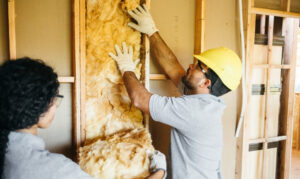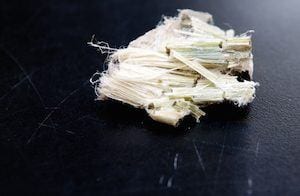Many workers used asbestos-containing insulation to make buildings, ships, and boilers fireproof. Unfortunately, exposure to asbestos-based insulation put these workers at an increased risk of developing the deadly cancer mesothelioma later in life. Get help if you or a loved one worked as an insulator and now has mesothelioma.
Is Mesothelioma Caused by Insulation?
Yes, exposure to asbestos-based insulation can cause mesothelioma.
 Between the 1930s and early 1980s, insulation materials often contained asbestos. Major manufacturers knew the dangers of asbestos during this time but hid them. Today, asbestos is known to cause mesothelioma and other diseases.
Between the 1930s and early 1980s, insulation materials often contained asbestos. Major manufacturers knew the dangers of asbestos during this time but hid them. Today, asbestos is known to cause mesothelioma and other diseases.
Any insulator that worked with or around asbestos insulation is at risk of mesothelioma. This was especially true of insulators who served in the U.S. military or who worked on docks or shipyards.
The U.S. Navy required asbestos use on all ships for decades. This is because asbestos is a great insulator and is flame resistant. Further, the danger was kept a secret from the military.
If you installed asbestos-containing insulation and now have mesothelioma, you may qualify for military benefits, health care services, and financial aid. Learn more in our Free Veterans Packet.
Why Was Asbestos Used in Insulation?
Asbestos-containing insulation was cheap, soundproof, and fire-resistant. Using it also helped save money on heating and cooling. This made it a valuable choice to use in buildings, ships, and other assets.
That said, the makers of asbestos-based products like insulation knew the dangers for decades. Instead of warning the general public, they actively concealed the facts to keep their profits high.
Once the truth came to light, asbestos was phased out of many insulation products. Still, it was too late for the thousands of insulators who were already exposed and put at risk of mesothelioma.
Vermiculite Insulation and Mesothelioma Risks
It isn't just asbestos insulation that can put people at risk of mesothelioma. Insulation was once commonly made out of vermiculite, a mineral that is often found near asbestos in natural rock deposits.
 For most of the 20th century, most vermiculite sold in the United States was mined from one place: Libby, Montana. However, the mine was contaminated with asbestos and at least 1 in 10 Libby citizens now have asbestos-related diseases like mesothelioma.
For most of the 20th century, most vermiculite sold in the United States was mined from one place: Libby, Montana. However, the mine was contaminated with asbestos and at least 1 in 10 Libby citizens now have asbestos-related diseases like mesothelioma.
If your home has vermiculite insulation, the Environmental Protection Agency (EPA) says you should assume it's laced with asbestos. If you're an insulator, make sure to assess the dangers before starting any work.
How Were Insulators Exposed to Asbestos?
An insulator’s job involves replacing, repairing, or installing materials used to insulate buildings. These materials all could have contained asbestos before the early 1980s.
As insulators worked, asbestos fibers could enter the air. Insulation workers may have breathed in or swallowed the fibers without notice. The fibers would then get trapped in the body, causing long-term damage and cancers like mesothelioma 10-50 years later.
To make matters worse, the insulation may have been held in place by asbestos-containing adhesives, tape, wire, or staples. This further exposed the insulators to asbestos.
 Working with these other asbestos-containing products could release even more asbestos fibers into the air.
Working with these other asbestos-containing products could release even more asbestos fibers into the air.
The health impacts of asbestos exposure among insulation workers have been devastating. In a 2017 study led by members of the National Institute for Occupational Safety and Health, insulators were found to have one of the highest mesothelioma patient mortality rates.
Even though there's less asbestos in use today, insulators are still at risk if they work on older buildings or ships. Further, because it can take 10-50 years from exposure to developing mesothelioma, many insulators may still be awaiting diagnosis.
Where Was Asbestos-Based Insulation Used?
Insulation that used asbestos could be found throughout buildings, aircraft, and ships.
Asbestos insulation was used in:
- Attics: Many attics used insulation to keep them cool. One common insulation type used in attics was Zonolite. This is the brand name for vermiculite insulation and it was commonly contaminated with asbestos.
- Blocks: Also known as wall insulation, block insulation is pure asbestos that is shaped into boards or bricks.
- Pipes: Pipe insulation was around various types of pipes in buildings and ships. For example, steam pipes heavily relied on asbestos insulation.
- Spray-applied asbestos: This is a cheap way of insulating homes and buildings in areas such as ceilings, walls, and attics. One of the most common additives used in spray-applied insulation was asbestos. Its use continued until 1990 when it was finally banned.
- Valve insulation jackets: This was the type of insulation used to insulate expansion joints, pipework, flanges, boilers, and other equipment that was sensitive to extreme temperatures.
- Other building materials: Roofs, walls, floor, and ceiling tiles could all contain asbestos as well.
In particular, U.S. veterans with mesothelioma who worked with insulation on Navy ships had a very high risk of exposure. These veterans had to handle asbestos insulation on a daily basis, and since Navy vessels were so cramped and had poor ventilation, the fibers could remain in the air for hours at a time.
Help for Insulators With Mesothelioma
If you or a loved one worked as an insulator and have been diagnosed with mesothelioma, there is help available.
Manufacturers of asbestos insulation knew the dangers yet still allowed its use. You can hold them accountable by filing mesothelioma claims.
On average, these legal claims award between $1 million and $1.4 million in settlement compensation that can be used to cover the costs of mesothelioma treatment and other expenses.
Further, if you were exposed to asbestos insulation while serving in the U.S. military, you may also be eligible for veterans benefits from the U.S. Department of Veterans Affairs (VA). These benefits include medical care from world-class mesothelioma doctors as well as financial assistance for you and your family.
Learn about all the benefits you may qualify for in our Free Veterans Packet.
FAQs About Mesothelioma and Insulators
Does insulation have asbestos in it?
Yes, asbestos was commonly used in insulation before the 1980s, when the dangers of this material became known to the public.
Can insulation cause mesothelioma?
Yes. If you've been exposed to insulation that contains asbestos, you may be at risk of developing mesothelioma and other serious illnesses.
What is the insulating material in asbestos?
Asbestos in and of itself was considered to be a good insulating material before the dangers were known.
Asbestos fibers are very durable and heat resistant. By using asbestos in insulation, buildings, ships, and other structures could be protected.
However, asbestos fibers also cause mesothelioma 10-50 years after insulation workers (and anyone else) are exposed.
Can you still use asbestos insulation?
Insulators are highly discouraged from using asbestos insulation in new projects due to the health risks.
In fact, as part of a 2019 ruling from the EPA, new insulation that uses asbestos cannot be made or sold until the agency reviews the products in question.
If you live in a home that contains asbestos-based insulation, make sure to get it inspected. Asbestos professionals can determine if it needs to be removed or not.
Is asbestos a thermal insulator?
Yes, asbestos is a thermal insulator. This is why it was used between the 1930s and early 1980s to insulate thousands of buildings and other structures.
Asbestos is fireproof, soundproof, and very sturdy. But the benefits don't outweigh the deadly drawbacks. Exposure to asbestos insulation causes mesothelioma and other health problems.
As a result, the use of asbestos insulation is significantly limited in the present day.

